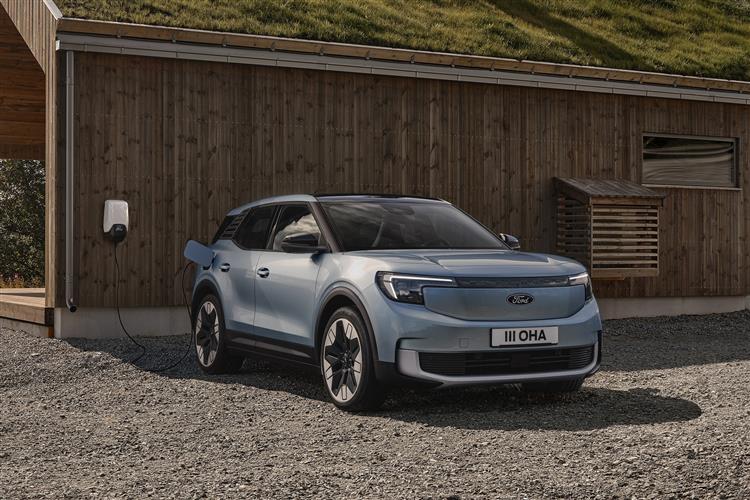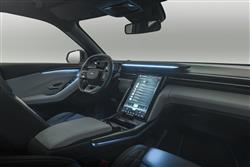EX-TREME MEASURES (some text hidden) --NONE--
By Jonathan Crouch
Ford's all-electric Explorer mid-sized SUV reflects the urgency of Ford's need to get into the mainstream EV market. Jonathan Crouch drives it.
Ten Second Reviewword count: 66
This electric Ford Explorer wasn't the brand's first EV, but it was the company's first really significant step into this market. A mid-sized SUV that runs on a Volkswagen chassis and powertrain, but in every other way has been developed to look, feel and drive as a European Ford should. It's impossible to over-state the significance here: for its maker, this car just has to work.
Backgroundword count: 248
Most car companies are changing simply because they've started making EVs. For Ford, the difference goes a bit deeper than that. Tired of years of losses (£1.6 billion in 2022), the brand's board must have considered following General Motors in pulling out of Europe completely. Instead, they've turned the model range on its head, dispensed with 380,000 staff, closed a key factory (Saarlouis in Germany) and signed off eventual death warrants for Ford's two most recognisable model nameplates, Focus and Fiesta. In place of the Fiesta, at the company's German Cologne plant will be made this car, the Explorer. You might vaguely know the Explorer name because it designates a big SUV hugely successful in the US, marketed briefly in the UK between 1997 and 2001 and lately sold in small numbers (as a Plug-in Hybrid) in Europe. This latest mid-sized Explorer is a slightly smaller SUV than that and of course it's all-electric, sharing its battery, MEB platform and basic architecture with the Volkswagen ID.4 as part of an agreement with Volkswagen which Ford reciprocates for by building VW-badged commercial vehicles in South Africa and Turkey. But you want to know about the Explorer, created as one of the company's four new 'product banner' sales categories, this one categorising SUVs and known as 'Adventurous Spirit'. The Blue Oval maker insists that, despite the shared underpinnings, this is a proper Ford in the way it drives, the way it looks and its cabin feel. Is it? Let's see.
Engines and Tech Specword count: 426
The Blue Oval brand promises that this Explorer will 'feel like a Ford' to drive. Which you might think a bit of a stretch given its Volkswagen MEB chassis and battery pack combination. In any case, given the company's new-found desire to trade on its American roots and the forgettable handling characteristics of most of its previous US market mainstream models, you might question whether a 'Ford-like' feel is even desirable here anyway. Undaunted, engineering manager Thomas Riehm promises that the car's steering, brakes, dampers, springs and anti-roll bars are specifically tuned for 'Ford-ness' and the Explorer gets its own bespoke Continental tyres. But we're back to 'VW ID.4'-ness when it comes to the basic engineering detail here: rear wheel drive and a choice of two mainstream variants. Either a base 52kWh version with a 170PS motor and up to 233 miles of combined cycle range. Or a rear-driven 77kWh derivative with a 286PS motor and up to 374 miles of range. As with the ID.4, there's also a dual motor AWD model at the top of the line-up, though here it produces 340PS (significantly more than a comparable ID.4 GTX) - and has a slightly larger 79kWh battery too, offering up to 329 miles of range. It's the AWD variant we tried, where (with 679Nm of torque to draw upon) 62mph is dispatched in 5.3s (quicker than a Focus ST hot hatch) en route to the 112mph top speed that all bigger-battery Explorers share. Even the ordinary 286PS rear-driven model has 545Nm of pulling power and manages the 62mph benchmark in 6.4s, so you won't really feel this car's 2.1-tonne kerb weight unless you opt for the base 52kWh 170PS version, which struggles a bit more with it, needing 8.7s to get to 62mph en route to 99mph. Earlier models in Explorer history were all SUVs, regularly used for towing. This electric Explorer won't be, though it can tug along a tonne - or 1,200kgs in the case of this dual motor version. And what of all that 'Ford-ness' we were promised? Well you'd get slightly more of that if you were to opt for this car's almost identically-engineered EV showroom stablemate, the Blue Oval brand's new-era Capri. Ford thinks Explorer customers won't be so worried about driver engagement, which is just as well because that's in relatively short supply here. Having said that, thanks to relatively feelsome steering, it's a more involving thing to drive than an equivalent Volkswagen ID.4 (which was clearly the objective here). The ride isn't quite as smooth mind you.
To see the full road test text contact us on 0330 0020 227
Pictures (high res disabled)

.jpg)
|
.jpg)
|
.jpg)
| |||
.jpg)
|
.jpg)
|
.jpg)
| |||
.jpg)
|
.jpg)
|
.jpg)
| |||
.jpg)
|
.jpg)
|
.jpg)
| |||

|
Statistics (subset of data only)
Min |
Max |
|
Price: |
£39,285.00 (At 21 Apr 2025, 52kWh Style) |
£53,985.00 (At 21 Apr 2025, 79kWh AWD) |
Insurance group 1-50: |
19 |
32 |
Max Speed (mph): |
99 (52kWh) |
112 (79kWh AWD) |
0-62 mph (s): |
8.7 (52kWh) |
5.3 (79kWh AWD) |
Electric WLTP-Rated Driving Range (miles): |
221 |
|
Length (mm): |
4468 |
|
Width (mm): |
1871 |
|
Height (mm): |
1630 |
|
Boot Capacity (l): |
445 |
470 |
... and 2 other stats available | ||
Scoring (subset of scores)
Category: Hybrid, Plug-in, Electric & Hydrogen
| Performance | |
| Handling | |
| Comfort | |
| Space | |
| Styling, Build, Value, Equipment, Depreciation, Handling, Insurance and Total scores are available with our full data feed. | |



